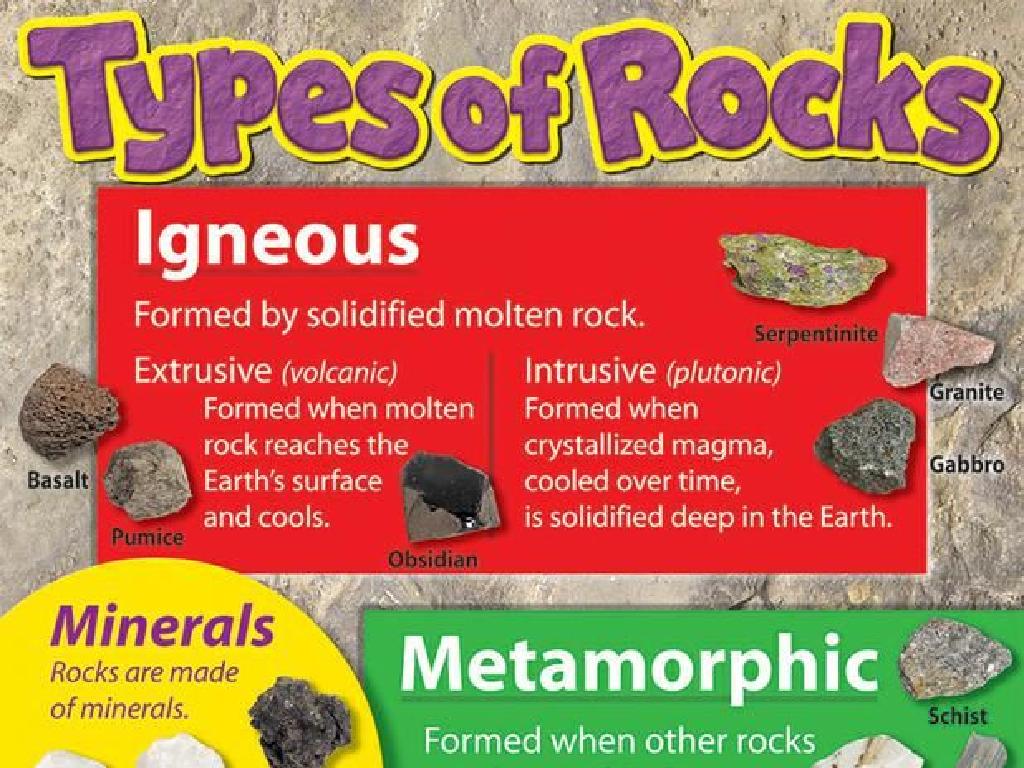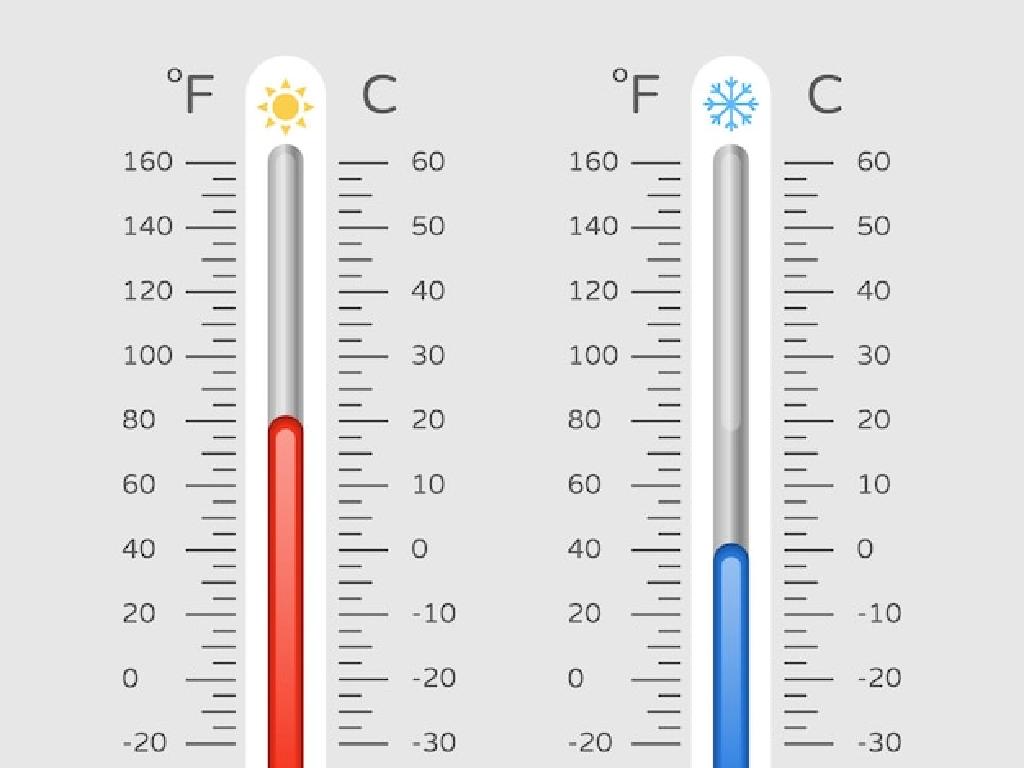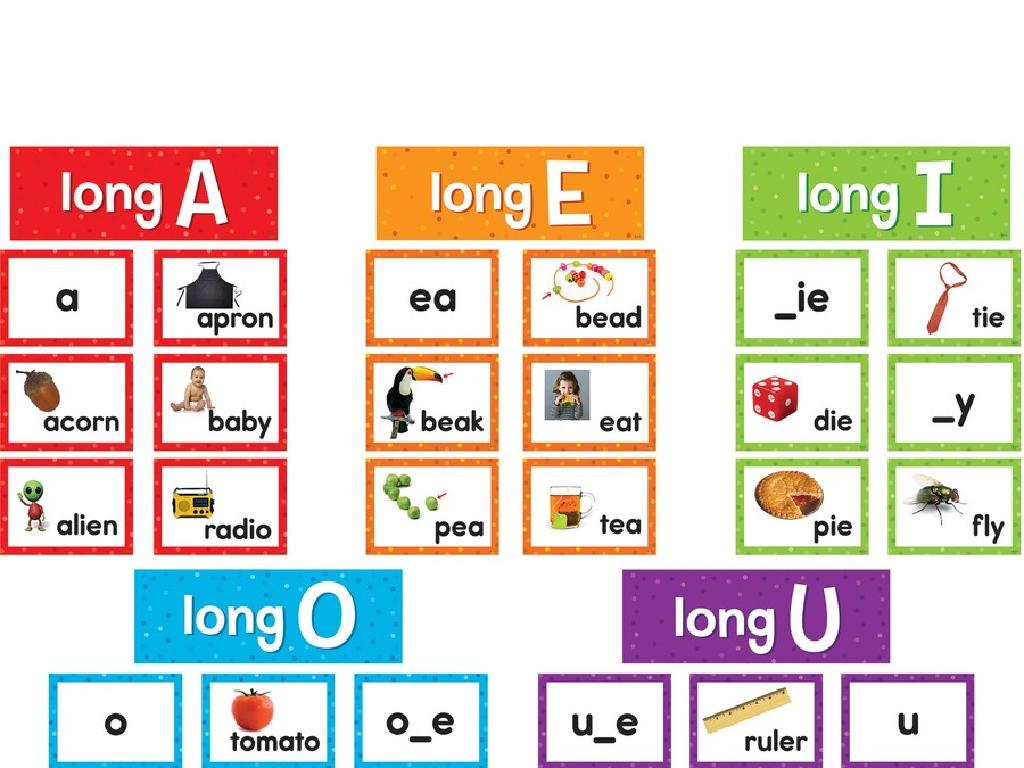How Do Sedimentary Rocks Form?
Subject: Science
Grade: Fifth grade
Topic: Rocks
Please LOG IN to download the presentation. Access is available to registered users only.
View More Content
Today’s Adventure: Sedimentary Rocks
– Explore the rock cycle
– The rock cycle shows how rocks change over time.
– Define sedimentary rocks
– Rocks made from sediments like sand, silt, and clay.
– How sedimentary rocks form
– Layers of sediments pile up and harden over years.
– Examples of sedimentary rocks
– Sandstone and shale are common sedimentary rocks.
|
Begin the lesson by explaining the rock cycle, emphasizing that it’s a series of processes that create and transform the types of rocks. Introduce sedimentary rocks as one of the three main rock types, formed from the accumulation of sediment. Explain that these sediments can come from broken down rocks, minerals, and organic matter, which are transported by water, wind, or ice and deposited in layers. Over time, these layers are compacted and cemented together to form sedimentary rocks. Provide examples like sandstone, formed from sand, and shale, formed from mud, to help students visualize the concept. Encourage students to bring in examples of sedimentary rocks they find in their environment or to look for them during their next outdoor adventure.
Exploring Sedimentary Rocks
– What is a rock?
– Solid material composed of different minerals
– Types of rocks
– Igneous, Metamorphic, and Sedimentary
– Sedimentary rocks origin
– Formed from layers of sediment
– Sedimentary rocks formation
|
Begin the lesson by defining a rock as a solid material that is made up of one or more minerals. Explain that there are three main types of rocks: igneous, formed from cooled magma or lava; metamorphic, which are altered by heat and pressure; and sedimentary, which are formed from the accumulation of sediment. Focus on sedimentary rocks, explaining that they are typically formed in water as small particles settle and accumulate in layers over time. These particles can include fragments of other rocks, minerals, and organic material. Over long periods, the layers are compressed and cemented together to form sedimentary rocks. Use examples like sandstone and limestone to illustrate sedimentary rocks. Encourage students to think about and discuss the different processes that could lead to the formation of sedimentary rocks.
The Rock Cycle and Sedimentary Rocks
– The Rock Cycle explained
– Rocks change over time through various processes
– Formation of Sedimentary Rocks
– Made from particles or sediments compacted at Earth’s surface
– Connection to other rocks
– They can transform into metamorphic or igneous rocks
– Sedimentary rocks’ role in the cycle
– They are often found in layers and can contain fossils
|
This slide introduces the concept of the rock cycle, emphasizing the continuous transformation of rock types over geological time. Sedimentary rocks form one part of the cycle, created from the compaction and cementation of various sediments at the Earth’s surface. Highlight the connection between sedimentary, metamorphic, and igneous rocks, explaining that sedimentary rocks can be subjected to heat and pressure to become metamorphic, or can melt and cool to form igneous rocks. Discuss the importance of sedimentary rocks in the cycle, noting their distinct layered appearance and potential to hold fossils, which can provide valuable information about Earth’s history. Encourage students to think about how rocks they see in their environment might have changed over time and what type of rocks they might be.
Formation of Sedimentary Rocks
– Weathering: Rocks break down
– Caused by water, wind, and ice
– Erosion: Sediments are moved
– Water, wind carry small pieces away
– Deposition: Sediments settle
– In water bodies or land, layers form
– Layers compress into rock
– Over time, layers harden into sedimentary rock
|
This slide outlines the process of sedimentary rock formation, which is essential for understanding Earth’s geology. Begin with weathering, where rocks are broken down into smaller pieces by natural forces like water, wind, and ice. Next, discuss erosion, where these small pieces, called sediments, are transported by water or wind. Then, explain deposition, where these sediments settle in layers in new locations, such as riverbeds or ocean floors. Over time, the weight of the layers compresses the sediments, and they harden into sedimentary rocks. Use examples like sandstone and shale to illustrate sedimentary rocks. Encourage students to think of this process like building a sandcastle layer by layer.
Layers of Sedimentary Rocks
– Sediments settle in layers over time
– Like a cake, sediments pile up layer by layer
– Fossils found within these layers
– Fossils are remains of ancient life, often found between layers
– Each layer represents a time period
– Think of it like pages in a history book
– Layers reveal Earth’s historical changes
– Geologists study layers to understand past environments
|
This slide aims to explain the concept of layering in sedimentary rocks to fifth-grade students. Emphasize that sediments, like sand, mud, and pebbles, are carried by water and wind and settle in layers over time, much like how a cake is made with different layers. Fossils, which are the preserved remains or impressions of ancient life, are often found within these layers and can tell us a lot about what life was like during that time. Each layer of sedimentary rock corresponds to a different period in Earth’s history, and by studying these layers, geologists can piece together the environmental and climatic changes that have occurred. Encourage students to think of the Earth as having a giant history book with each layer of rock representing a different chapter.
Types of Sedimentary Rocks
– Clastic sedimentary rocks
– Formed from broken pieces of other rocks
– Chemical sedimentary rocks
– Created when water evaporates leaving minerals
– Organic sedimentary rocks
– Composed of plant and animal remains
|
This slide introduces students to the three main types of sedimentary rocks. Clastic sedimentary rocks are made from fragments, or ‘clasts’, of other rocks that have been compacted and cemented over time. Chemical sedimentary rocks form when minerals precipitate from water solutions, often as the water evaporates, leaving a mineral deposit behind. Organic sedimentary rocks are composed of the remains of once-living plants and animals, such as coal, which is made from ancient plant material. Encourage students to think of examples and ask them to consider how each type of rock might look different based on its formation process.
Sedimentary Rocks in Nature
– Grand Canyon formation
– A vast landscape carved by erosion, revealing sediment layers.
– Great Barrier Reef as sedimentary
– The world’s largest coral reef system, made from biological sediments.
– Spotting sedimentary rocks locally
– Look for rocks with layers or that are crumbly at the park or in your yard.
– Everyday uses of sedimentary rocks
– Limestone in buildings, sandstone in tiles, and coal for energy.
|
This slide aims to show students how sedimentary rocks are not just a topic in textbooks but are present in monumental natural formations and in our daily lives. The Grand Canyon, with its layered rock walls, is a classic example of sedimentary rock formation through years of erosion. The Great Barrier Reef, composed of skeletal remains, is another example of sedimentary structures. Encourage students to observe their environment for sedimentary rocks, which can often be found in common places. Discuss how these rocks are used in construction and energy, making them a significant part of our everyday life. This will help students appreciate the practical applications of what they learn in science class.
Class Activity: Create Your Own Sedimentary Rock
– Gather materials: sand, pebbles, shells, leaves
– Simulate rock formation steps
– Weathering breaks down rocks, erosion moves them, deposition layers them, compaction solidifies
– Observe the layers formed
– Notice how layers settle over time
– Discuss the learning outcomes
– Share observations on the rock cycle process
|
This hands-on activity is designed to help students understand the process of sedimentary rock formation through a fun and interactive project. Provide each student or group with the necessary materials. Guide them through simulating weathering by breaking down the leaves and pebbles, then erosion and deposition by mixing with sand and water in the container. Finally, they should press down to simulate compaction. Encourage students to observe the layering of materials and how they mimic natural rock formation. After the activity, lead a discussion on the steps of the rock cycle they’ve simulated and what they’ve learned about sedimentary rocks. This will reinforce their understanding of geological processes.





